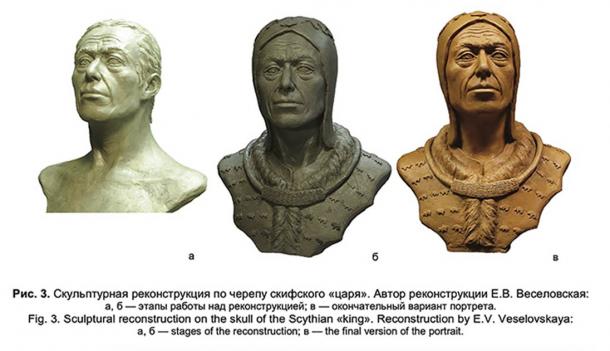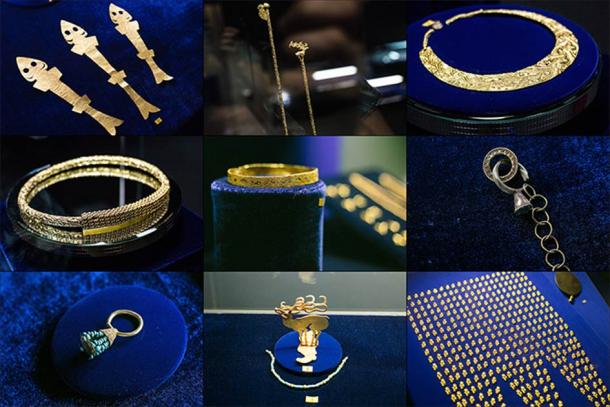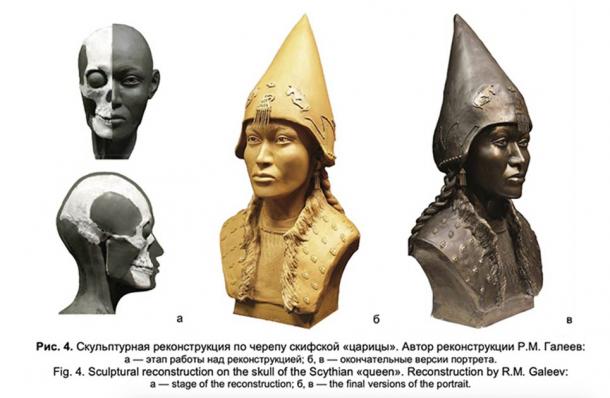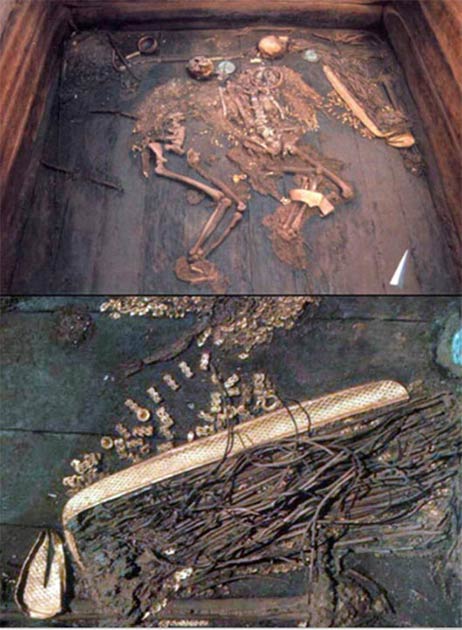High technology has brought back a pair of super wealthy ancient nomadic Scythian Empire nobles discovered in a gold laden tomb in East Siberia. Described as a “Scythian King and Queen,” their skeletons were first discovered by a Russian-German expedition in 1997 at the center of a wooden chamber beneath a 262-foot (80-meter) mound in the River Uyuk valley, in the remote Tuva Republic, a federal subject of Russia. Known as the “Arzhan-2 burial,” the two bodies, from the Scythian Empire period, were studied between 2001-2003. A recent report in the Siberian Times says that the 2,600 year old faces of the “Siberian Tutankhamun and his Queen” have now been reconstructed.
Scythian Empire Rulers: A Caucasoid and Mongoloid Mixture
An article in World Archaeology states that when the site was first discovered, at the center of the Scythian Empire burial mound , a wide funnel was left by a team of ancient grave robbers. However, they made “one big mistake” when they assumed that the burial tomb was in the center of the mound. Anticipating such criminal activity, the rectangular gold laden tomb was built slightly to one side of the circle at a depth of more than 13 feet (4 meters), and this is why it remained untouched until 1997.
Archaeologists also found the remains of 33 other people in the tomb, including five children, as well as the remains of 14 stallions dressed in gold, bronze, and iron.
Anthropologists from the Moscow Miklukho-Maklai Institute of Ethnology and Anthropology and the and Novosibirsk Institute of Archeology and Ethnography said the “battle-hardened Scythian warrior ,” or “King,” had a unique combination of Caucasoid and Mongoloid features.
Using laser scanning and photogrammetry, the team of researchers recreated detailed 3D models of the powerful couple’s two skulls.

Features of the Scythian king reconstructed from his skull. ( E. V. Veselovskaya )
The Scythian Empire King And Queen Were “Covered” In Gold
Moscow-based anthropologists Elizaveta Veselovskaya and Ravil Galeev published an article in the Russian Journal of Archeology, Anthropology and Ethnography . They say the radiocarbon dating of the king’s and queen’s remains proved that they lived at the end of the 9th century BC or in the early years of the 8th century BC, and that perhaps they had ruled vast regions of the steppes at that time
The rulers were found wearing gold-encrusted clothing and this too has been recreated in all it’s glory and is reconstructed at the Hermitage Museum with some of the Arzhan 2 collection. The rest of the extraordinarily valuable collection is held in Kyzyl, a Tuvan regional capital.

Some of the beautiful adornments found inside the Scythian Empire Arzhan-2 burial mound in the Tuva Republic. (Vera Salnitskaya / The Siberian Times )
The restoration-reconstruction project was carried out with sculptural clay and hard polyurethane foam. Only half of the “Tsar’s’ skull” was preserved and the researchers said they faced “great difficulties” restoring his facial area. The lower jaw was found to be preserved, however, and with this the 3D artists were able to reconstruct the destroyed upper jaw. Their two skulls were found dislocated from their bodies, as they had fallen from their long-decayed burial pillows. One theory suggests the woman might have been the “King’s” favorite concubine, who had been sacrificed to accompany him to the afterlife.

The reconstruction of the female Scythian Empire “Queen’s” face from her skull. ( E. V. Veselovskaya )
An Astonishingly Rich Scythian Empire Burial Tomb
According to a report in the Siberian Times , the find is described as an “astonishingly-rich burial.” The inside walls of the tomb were covered with felt carpets and a boarded wooden floor was also softened with felt.
The ancient male ruler was buried wearing a heavy gold torque (crown) decorated with figures of animals. And thousands of tiny golden panther figures measuring 0.79 to 1.2 inches (2 to 3 centimeters) in length were sewn in vertical rows on his clothes. The remains of a quiver, a bow and arrows, a belt, a battle axe, a whip, and a bronze mirror were all found with the king.
The so-called queen wore “turquoise beads, golden badges and pins, a miniature golden cauldron, a golden bracelet and a bag with cosmetics,” and on her belt she wore an iron dagger decorated with gold.

The Scythian Empire king and queen couple were literally found covered in gold. (Vera Salnitskaya / The Siberian Times )
All designed in the Scythian Empire art style , a total of 9,300 individual gold artifacts were found in the tomb including “golden earrings, pendants and uncountable beads.” In total, this was an astonishing 44 pounds (20 kilograms) of gold.
Dr Mikhail Piotrovsky, director of the Hermitage Museum, told the New York Times that the tomb was “an encyclopaedia of Scythian Animal Art,” featuring the panthers, lions, camels, and deer that roamed the region 2,600 years ago. The researchers added that the artistic style “almost resembles an Art Nouveau” design, and that this original Altai-region Scythian style eventually reached as far as the Black Sea region and the territories of ancient Greece.
Top image: A king and queen of the Scythian Empire reconstructed from their skulls found in the Altai region burial mound. Source: Elizaveta Veselovskaya, Ravil Galeev / Siberian Times
By Ashley Cowie
Related posts:
Views: 0
 RSS Feed
RSS Feed















 January 16th, 2021
January 16th, 2021  Awake Goy
Awake Goy  Posted in
Posted in  Tags:
Tags: 
















